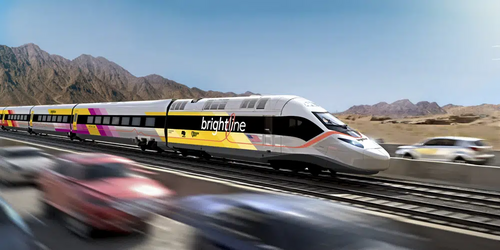
This undated illustration provided by Brightline West shows an illustration of the Brightline West High Speed Rail project train from Las Vegas to Rancho Cucamonga, Calif. A bipartisan congressional group from Nevada and California asked the Biden administration on Monday, April 24, 2023, to fast-track federal funds for a private company to build a high-speed rail line between Las Vegas and the Los Angeles area. (Brightline West via AP)
LAS VEGAS (AP) — A bipartisan congressional group from Nevada and California asked the Biden administration Monday to fast-track federal funds for a private company to build a high-speed rail line between Las Vegas and the Los Angeles area.
All six of Nevada’s elected federal lawmakers and four House members from California sent the letter to U.S. Transportation Secretary Pete Buttigieg. They said they’re on board with a proposal from Brightline West to spend more than $10 billion to lay tracks along the Interstate 15 corridor.
Traffic jams on the interstate often stretch for 15 miles (24 kilometers) near the Nevada-California line as motorists head home after weekend or holiday travel to Las Vegas.
The Mojave Desert is largely open space, and the electric-powered trains could potentially cut the four-hour trip in half, carrying passengers at speeds of nearly 200 mph (322 kph).
“This project is a major priority because it will make southern Nevada more accessible to millions of visitors each year,” said U.S. Sen. Jacky Rosen, the Nevada Democrat leading the group. She said it “will boost our economy and create more good-paying jobs.”
Union labor will be used during construction, the company and the Southern Nevada Building Trades Union have announced in recent weeks.
Brightline West is seeking $3.75 billion in federal funding from the Biden administration-backed federal infrastructure law.
The project could be “the blueprint for how we can connect major city pairs that are too short to fly and too far to drive,” said Mike Reininger, CEO of Florida-based Brightline Holdings LLC, the only privately owned and operated intercity passenger railroad in the United States.
The lawmakers’ letter pointed to company projections of 35,000 construction jobs, 1,000 permanent jobs and reduced planet-warming greenhouse gas emissions from vehicles.
A draft environmental assessment of the Nevada-California project was made public last October 2022 and the Federal Railroad Administration is expected to finalize permits in July. The company said about 70% of funding will be private, using a combination of debt and equity.
Amtrak passenger service to Las Vegas ended in 1997 with the demise of a train called the Desert Wind. The concept of building a bullet train through the Mojave Desert dates back to at least 2005 under various names. It has seen starts and stops over the years and became sidetracked during the COVID-19 pandemic.
In Florida, Brightline West’s sister company began sharing the Florida East Coast freight line between Miami and West Palm Beach in 2014 and is building an extension to Orlando. High-speed trains running through urban areas have drawn criticism for numerous crashes with vehicles at rail crossings. Investigators found deaths were not the railroad’s fault, determining that many were suicides or drivers or pedestrians trying to beat the trains.
Other places where high-speed trains have been proposed include the 240 miles (386 kilometers) from Dallas to Houston in Texas, and a 500-mile (805-kilometer) system linking Los Angeles and San Francisco.
The California line depends on funding and other unknowns.
A 2023 report by the California High-Speed Rail Authority says environmental clearance has been obtained for 422 miles (679 kilometers) and construction is underway for 119 miles (191 kilometers) in California’s Central Valley.
Cost estimates have swelled to more than $100 billion — far greater than the $33 billion that voters approved in 2008.
In Texas, a study published last month by Reason Foundation, a libertarian think tank, concluded the state’s fast rail project is stalled by climbing costs, lack of legislative support and opposition from farmers, ranchers, and other landowners “who objected to having their land bisected by a train traveling at 200 miles per hour over 30 times each day.” It noted the Texas Legislature passed a law prohibiting spending any funds on the project.
Brightline West trains would connect Las Vegas, Victorville, California, and Rancho Cucamonga — a city in San Bernardino County with a passenger station on a suburban Los Angeles light rail line.
U.S. Sen. Catherine Cortez Masto, a Democrat, and Nevada’s four House members including Republican Mark Amodei signed the letter with Rosen seeking federal-state partnership funding through the Federal Railroad Administration’s Intercity Rail Grant Program.
California Democratic House members Nanette Barragán and Jimmy Gomez from the Los Angeles area and John Garamendi of the East Bay area signed on, along with Republican Jay Obernolte, who represents the Victorville and San Bernardino County area.
“This bipartisan delegation from Nevada and California are pleased to support the federal resources necessary to develop essential transportation access between this highly trafficked corridor,” the lawmakers said.
___
This story was updated to correct that Amtrak service to Las Vegas ended in 1997, not 1991.
Source (Archive)
